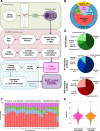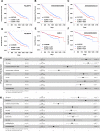Characterization of complete lncRNAs transcriptome reveals the functional and clinical impact of lncRNAs in multiple myeloma
- PMID: 33597729
- PMCID: PMC8102198
- DOI: 10.1038/s41375-021-01147-y
Characterization of complete lncRNAs transcriptome reveals the functional and clinical impact of lncRNAs in multiple myeloma
Abstract
Multiple myeloma (MM) is an incurable disease, whose clinical heterogeneity makes its management challenging, highlighting the need for biological features to guide improved therapies. Deregulation of specific long non-coding RNAs (lncRNAs) has been shown in MM, nevertheless, the complete lncRNA transcriptome has not yet been elucidated. In this work, we identified 40,511 novel lncRNAs in MM samples. lncRNAs accounted for 82% of the MM transcriptome and were more heterogeneously expressed than coding genes. A total of 10,351 overexpressed and 9,535 downregulated lncRNAs were identified in MM patients when compared with normal bone-marrow plasma cells. Transcriptional dynamics study of lncRNAs in the context of normal B-cell maturation revealed 989 lncRNAs with exclusive expression in MM, among which 89 showed de novo epigenomic activation. Knockdown studies on one of these lncRNAs, SMILO (specific myeloma intergenic long non-coding RNA), resulted in reduced proliferation and induction of apoptosis of MM cells, and activation of the interferon pathway. We also showed that the expression of lncRNAs, together with clinical and genetic risk alterations, stratified MM patients into several progression-free survival and overall survival groups. In summary, our global analysis of the lncRNAs transcriptome reveals the presence of specific lncRNAs associated with the biological and clinical behavior of the disease.
Conflict of interest statement
The authors declare that they have no conflict of interest.
Figures




References
-
- Laubach JP, Richardson PG, Anderson KC. The evolution and impact of therapy in multiple myeloma. Med Oncol. 2010;27:S1–6. - PubMed
-
- Zhuang W, Ge X, Yang S, Huang M, Zhuang W, Chen P, et al. Upregulation of lncRNA MEG3 promotes osteogenic differentiation of mesenchymal stem cells from multiple myeloma patients by targeting BMP4 transcription. Stem Cells. 2015;33:1985–97. - PubMed
Publication types
MeSH terms
Substances
Grants and funding
LinkOut - more resources
Full Text Sources
Other Literature Sources
Medical
Molecular Biology Databases

